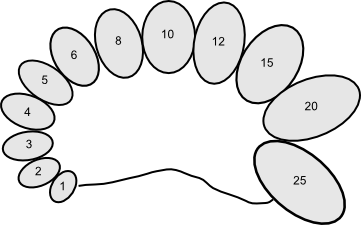This article includes a list of general references, but it lacks sufficient corresponding inline citations. (February 2013) |
An orchidometer (or orchiometer) is a medical instrument used to measure the volume of the testicles.

Instrument
editThe orchidometer was introduced in 1966 by Swiss pediatric endocrinologist Andrea Prader of the University of Zurich.[1] It consists of a string of twelve numbered wooden or plastic beads of increasing size from about 1 to 25 millilitres. Doctors sometimes informally refer to them as "Prader's balls", "the medical worry beads", or the "endocrine rosary".[2]
The beads are compared with the testicles of the patient, and the volume is read off the bead which matches most closely in size. Prepubertal sizes are 1–3 ml, pubertal sizes are considered 4 ml and up and adult sizes are 15-25 ml.[2]
The orchidometer can be used to accurately determine size of testes. Discrepancy of testicular size with other parameters of maturation can be an important clue to various diseases. Small testes can indicate either primary or secondary hypogonadism. Testicular size can help distinguish between different types of precocious puberty. Since testicular growth is typically the first physical sign of true puberty, one of the most common uses is as confirmation that puberty is beginning in a boy with delayed puberty. Large testes (macroorchidism) can be a clue to one of the most common causes of inherited generalised learning disability, fragile X syndrome.
Stephen Shalet, a leading endocrinologist who works for the Christie Hospital in Manchester, is reported to have told The Observer: "Every endocrinologist should have an orchidometer. It's his stethoscope."[citation needed]
Orchidometers are also commonly used to measure testicular volume of rams.
Related concept
editNumerous clinical scales and measurement systems exist to define genitals as normal male or female, or "abnormal", including the Prader scale, Quigley scale. and the satirical Phall-O-Meter.[citation needed]
References
edit- ^ Page 16 in: Richter-Unruh, Annette; Doerfer, Jürgen; Schwab, Karl Otfried (2018). "Körperliche Entwicklung im Jugendalter" [Physical development in adolescence]. Jugendmedizin [Adolescent medicine] (in German). pp. 3–18. doi:10.1007/978-3-662-52783-2_1. ISBN 978-3-662-52782-5.
- ^ a b Page 86 in: Hindmarsh, Peter C.; Geertsma, Kathy (2017). "Puberty". Congenital Adrenal Hyperplasia. pp. 83–94. doi:10.1016/B978-0-12-811483-4.00007-6. ISBN 978-0-12-811483-4.
Further reading
edit- Prader, A. (1966). "Testicular size: assessment and clinical importance". Triangle. 7 (6): 240–243. PMID 5920758.
- Taranger, J.; Engström, I.; Lichtenstein, H.; Svennberg-Redegren, I. (April 1976). "Somatic Pubertal Development". Acta Paediatrica. 65 (S258): 121–135. doi:10.1111/j.1651-2227.1976.tb14766.x. PMID 1066958.
- Lin, Chih-Chieh; Huang, William J. S.; Chen, Kuang-Kuo (12 November 2009). "Measurement of Testicular Volume in Smaller Testes: How Accurate Is the Conventional Orchidometer?". Journal of Andrology. 30 (6): 685–689. doi:10.2164/jandrol.108.006460. PMID 19578133.
- Behre, H. M.; Nashan, Dorothée; Nieschlag, E. (December 1989). "Objective measurement of testicular volume by ultrasonography: evaluation of the technique and comparison with orchidometer estimates". International Journal of Andrology. 12 (6): 395–403. doi:10.1111/j.1365-2605.1989.tb01328.x. PMID 2696729.
- Sakamoto, Hideo; Saito, Katsuyuki; Ogawa, Yoshio; Yoshida, Hideki (January 2007). "Testicular Volume Measurements Using Prader Orchidometer Versus Ultrasonography in Patients with Infertility". Urology. 69 (1): 158–162. doi:10.1016/j.urology.2006.09.013. PMID 17270640.
- Diamond, David A.; Paltiel, Harriet J.; DiCanzio, James; Zurakowski, David; Bauer, Stuart B.; Atala, Anthony; Ephraim, Patti L.; Grant, Rosemary; Retik, Alan B. (September 2000). "Comparative Assessment of Pediatric Testicular Volume: Orchidometer Versus Ultrasound". Journal of Urology. 164 (3 Part 2): 1111–1114. doi:10.1016/S0022-5347(05)67264-3.